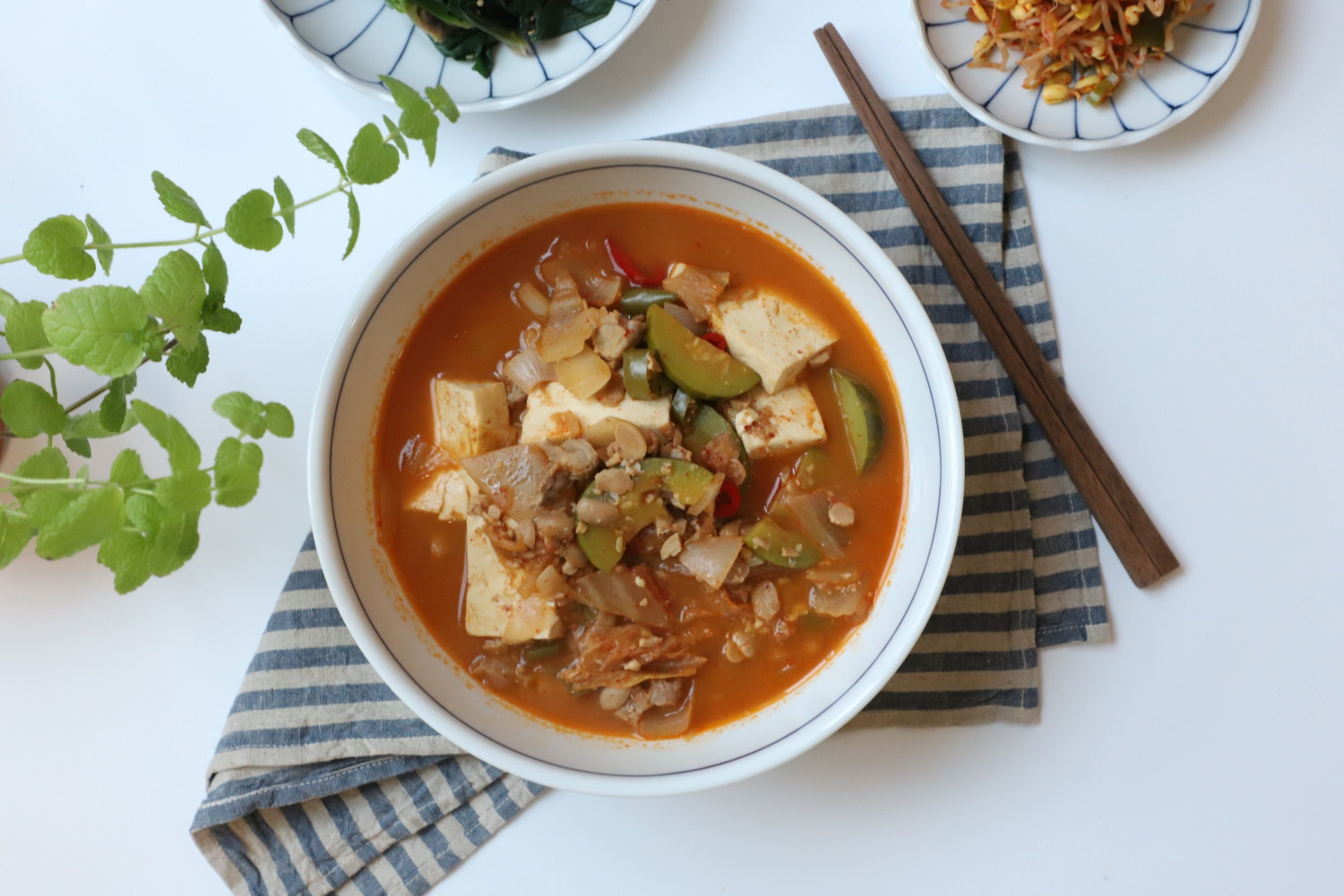Hearty Homemade Cheonggukjang Stew
How to Make Delicious Cheonggukjang: A Guide to Authentic Flavor

This Cheonggukjang stew is made with homemade fermented soybeans, resulting in a rich and savory flavor that’s truly authentic. Unlike restaurant versions that can be too strong, this recipe offers a mild yet deeply satisfying taste that’s delicious enough to eat on its own. Perfect for a healthy and comforting meal, this fragrant stew is sure to become a favorite.
Main Ingredients- 250g Cheonggukjang (fermented soybean paste)
- 150g Pork neck
- 2 leaves Napa cabbage kimchi (from a whole kimchi)
- 1/3 Zucchini
- 1/2 Onion
- 2 Cheongyang peppers (or other hot green peppers)
- 1 Red chili pepper
Seasoning & Broth- 1000ml (1L) Anchovy broth
- 2 Tbsp Korean soy sauce (Gukganjang)
- 1 Tbsp Minced garlic
- 1 Tbsp Gochugaru (Korean chili powder)
- 1000ml (1L) Anchovy broth
- 2 Tbsp Korean soy sauce (Gukganjang)
- 1 Tbsp Minced garlic
- 1 Tbsp Gochugaru (Korean chili powder)
Cooking Instructions
Step 1
First, pour 1000ml of water into a pot and add anchovies and dried kelp to make a flavorful anchovy broth. Simmer for about 10 minutes. This broth will be the base for your stew.

Step 2
Wash the zucchini thoroughly and slice it into half-moon shapes, about 0.5cm thick. Slicing them not too thinly will give them a pleasant texture when bitten into.

Step 3
Peel the onion and slice it into 0.5cm thick strips or dice it. The sweetness of the onion will enhance the overall flavor of the stew.

Step 4
Remove the stems from the Cheongyang peppers and chop them finely. If you prefer a spicier stew, you can leave the seeds in for extra heat.

Step 5
Also, remove the stems from the red chili pepper and chop it finely. Its vibrant red color will add visual appeal to the stew. (Optional ingredient)

Step 6
Cut the pork neck into bite-sized pieces, about 2-3cm. Adding pork will make the broth richer and more complex in flavor.

Step 7
Take the Napa cabbage leaves from your fermented kimchi and chop them into roughly 2-3cm pieces. The tangy flavor of the kimchi complements the savory notes of the Cheonggukjang beautifully, adding depth and zest.

Step 8
Prepare the star of today’s dish: the Cheonggukjang. Since it’s homemade, the anticipation for its unique aroma and taste is high. You can add it as is or mash it slightly.

Step 9
Now, let’s start cooking the stew. Pour the prepared anchovy broth (1000ml) into a pot. Add the sliced pork neck, 1 tablespoon of minced garlic, and the chopped kimchi. Bring to a boil over high heat and cook until the pork is mostly cooked through.

Step 10
Once the pork begins to cook (after about 5 minutes of simmering), add the sliced zucchini and onion to the pot and continue to cook. As the vegetables soften, they will release their natural sweetness and add a refreshing quality to the broth.

Step 11
After simmering for another 2-3 minutes with the vegetables, gently add the Cheonggukjang. Either add it in lumps or lightly mash it before adding, and carefully stir to dissolve it into the broth. Be gentle when stirring to preserve the rich flavor and aroma characteristic of Cheonggukjang.

Step 12
Finally, season the stew with 2 tablespoons of Gukganjang (Korean soy sauce) to adjust the saltiness. Add the chopped Cheongyang peppers and red chili pepper. (If you wish to add tofu, this is the time to do so, though it wasn’t in the original ingredient list.)

Step 13
Let the stew simmer for another moment to allow all the flavors to meld together, about 3-5 minutes. This will ensure the ingredients infuse their taste deeply into the broth, creating a delicious Cheonggukjang stew. Just before turning off the heat, stir in 1 tablespoon of Gochugaru for a touch of spicy warmth.

Step 14
The finished Cheonggukjang might taste mild, so adjust the seasoning with salt or more Gukganjang to your preference. You’ll find its savory and deep flavor is so satisfying that you might just want to eat it straight from the pot!

Step 15
Thanks to the wonderful savory taste of well-fermented Cheonggukjang, you’ll find yourself finishing a bowl of rice in no time. Enjoy this nutritious and delicious homemade Cheonggukjang meal! Cooking a large pot will ensure everyone in the family has a hearty and satisfying meal.



